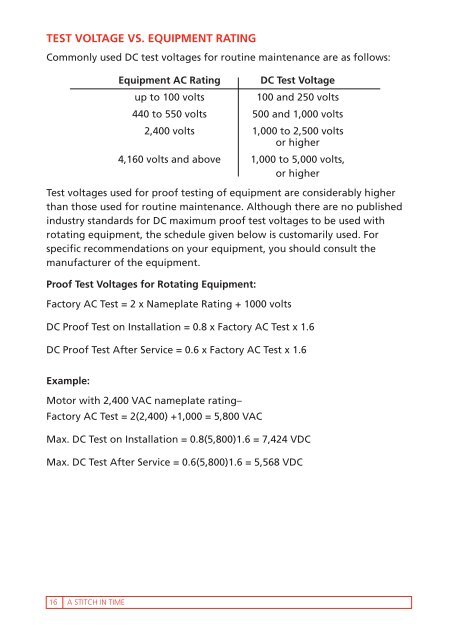“A Stitch in Time...”
You also want an ePaper? Increase the reach of your titles
YUMPU automatically turns print PDFs into web optimized ePapers that Google loves.
test Voltage vs. Equipment Rat<strong>in</strong>g<br />
Commonly used DC test voltages for rout<strong>in</strong>e ma<strong>in</strong>tenance are as follows:<br />
Equipment AC Rat<strong>in</strong>g DC Test Voltage<br />
up to 100 volts<br />
100 and 250 volts<br />
440 to 550 volts 500 and 1,000 volts<br />
2,400 volts 1,000 to 2,500 volts<br />
or higher<br />
4,160 volts and above 1,000 to 5,000 volts,<br />
or higher<br />
Test voltages used for proof test<strong>in</strong>g of equipment are considerably higher<br />
than those used for rout<strong>in</strong>e ma<strong>in</strong>tenance. Although there are no published<br />
<strong>in</strong>dustry standards for DC maximum proof test voltages to be used with<br />
rotat<strong>in</strong>g equipment, the schedule given below is customarily used. For<br />
specific recommendations on your equipment, you should consult the<br />
manufacturer of the equipment.<br />
Proof Test Voltages for Rotat<strong>in</strong>g Equipment:<br />
Factory AC Test = 2 x Nameplate Rat<strong>in</strong>g + 1000 volts<br />
DC Proof Test on Installation = 0.8 x Factory AC Test x 1.6<br />
DC Proof Test After Service = 0.6 x Factory AC Test x 1.6<br />
Example:<br />
Motor with 2,400 VAC nameplate rat<strong>in</strong>g–<br />
Factory AC Test = 2(2,400) +1,000 = 5,800 VAC<br />
Max. DC Test on Installation = 0.8(5,800)1.6 = 7,424 VDC<br />
Max. DC Test After Service = 0.6(5,800)1.6 = 5,568 VDC<br />
16<br />
A STITCH IN TIME



